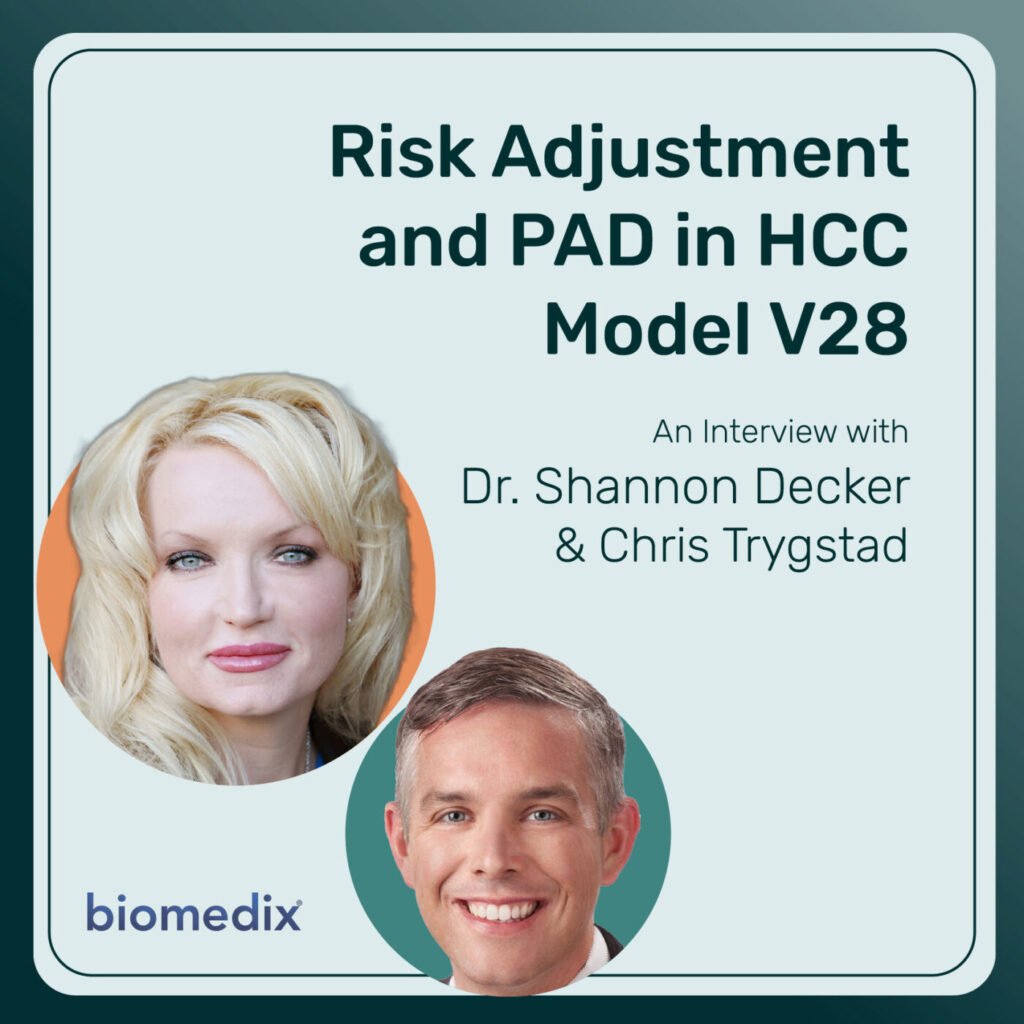
Have Additional Questions About PVD And The HCC v28 Model?
A new version (v28) of the CMS HCC risk adjustment model was finalized earlier this year. The new v28 model includes changes in the Medicare Advantage (MA) capitation rate and risk adjustment methodologies. These changes will significantly impact risk adjustment factor (RAF) scores and how health plans and medical practices manage patient risk and allocate resources. In this exclusive interview, I had an opportunity to specifically review the changes around Peripheral Artery Disease (PAD), how these changes may affect MA plans and risk-bearing medical groups, including those participating in ACO REACH and MSSP, and what should be done in preparation for the changes.
(This interview has been edited for conciseness and clarity.)
Chris Trygstad (CT): Dr. Decker, given your experience in developing and managing clinical protocols at NAMM, Brown & Toland, and now with numerous plans and risk bearing medical groups in your consulting capacity, the big question is, “Will PAD continue to risk adjust in v28?”
Dr. Decker: Yes! So there is no confusion, PAD will continue to risk adjust in v28. In fact, PAD with complications was previously documented using HCC code 107 with a RAF of 0.382. In the v28 model, PAD with rest pain is now documented with HCC code 264 and has a RAF of 0.455, representing a nearly 20% increase in RAF.
CT: So then why are some plans and risk-bearing medical groups thinking that PAD will no longer risk adjust once v28 is fully implemented?
Dr. Decker: The confusion is around PAD without complications that has historically been documented using HCC code 108. While PAD without complications is scheduled to stop risk adjusting in v28, PAD with complications such as rest pain or ulceration will continue to risk adjust. In fact, PAD with ulceration should be documented with HCC 263 in v28 and has a RAF of 1.118.
CT: Should I test at-risk members for PAD if they aren’t experiencing any complications?
Dr. Decker: Great question and the answer is yes. There are several reasons why I encourage my clients to actively assess PAD in their at-risk member populations. To begin with, PAD is a condition that can be effectively managed in the primary care setting if identified early. I’ve found diagnosis improves member compliance and the treatment options are more patient-friendly, less expensive, and support optimizing clinical outcomes when the disease is in an early state. Furthermore, members previously diagnosed with PAD without complications that are later found to have rest pain or ulceration gain access to additional resources through the risk adjustment associated with PAD and rest pain (HCC 264 and RAF 0.455) or PAD and ulceration (HCC 263 and RAF 1.118).
CT: Is there a cost benefit to screening for PAD?
Dr. Decker: Absolutely. As mentioned previously, PAD with documented complications risk adjusts in a material way in v28. But there are also significant financial and clinical benefits associated with the early identification of PAD. When patients are informed that they have a chronic condition such as PAD, even when they already have another chronic condition like diabetes, studies have shown people are more likely to make healthier life choices when properly educated about strategies to manage the condition and slow progression. Lifestyle modifications such as supervised exercise therapy, smoking cessation, and optimal medical therapy (OMT) are all highly effective options, both clinically and financially. But often, it is the diagnosis that drives member compliance. As you might imagine, if we can maintain the treatment and care of PAD in the primary care setting, we can avoid tremendous expenses associated with revascularization and the clinical consequences associated with amputation, stroke, and heart attack.
CT: Do I need to perform a diagnostic assessment for PAD if I’ve already observed the member is experiencing rest pain or has an ulcer?
Dr. Decker: Without question. A person may be experiencing rest pain due to arthritis or some other musculoskeletal disorder rather than PAD. Additionally, someone may have an ulcer due to pressure or blunt trauma. It is imperative that you perform a diagnostic assessment with technology like PADnet that can objectively quantify and document the presence of PAD. Especially when you put this in the context of a RADV audit. You will always want to make sure you have documentation that the member has PAD in addition to documenting the relevant co-morbidities.
CT: What is the prevalence of PAD in the Medicare Advantage population?
Dr. Decker: Clinical literature indicates that age is the most common risk factor for PAD, followed closely by diabetes and tobacco use. Studies have shown that populations aged 70 years old, or 50 years old and a history of diabetes or smoking have a base prevalence rate of 30%. However, combining one or more risk factors, including hypertension, hyperlipidemia, or advanced age, increases the prevalence. Consequently, the prevalence rate I most frequently hear from my clients is approximately two-thirds of all Medicare Advantage members or roughly 67%.
CT: Any recommendations to plans or risk-bearing medical groups that are considering whether to assess for PAD now or wait until v28 is fully implemented?
Dr. Decker: Definitely. Practices with a focus on MA members and obviously MA plans should be implementing PAD assessment programs as soon as possible. The v24 model will have a two-thirds weighting for 2024, and a one-third weighting in 2025. As a result, you can access additional financial resources to support the start-up costs associated with building and implementing a PAD screening program in advance of the full implementation of v28. It also enables strong positioning in 2026 to continue to leverage the financial resources that are enabled in v28 when you identify and document members with PAD and recognized indications such as rest pain or ulceration. As always, I love customizing clinical programs for plans and risk-bearing medical groups, so they have the resources necessary to cost effectively deliver best-in-class patient care.
Dr. Shannon I. Decker, PhD, MBA, MEd, is principal at VBC One, a consulting firm assisting physician groups, health plans, and vendors maximize the performance of their value-based contracts and offerings.
Chris Trygstad, MBA is a Vice President at Biomedix, a provider of front-line diagnostic solutions for delivering value-based care.


